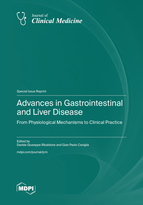Advances in Gastrointestinal and Liver Disease: From Physiological Mechanisms to Clinical Practice
A special issue of Journal of Clinical Medicine (ISSN 2077-0383). This special issue belongs to the section "Gastroenterology & Hepatopancreatobiliary Medicine".
Deadline for manuscript submissions: closed (15 October 2022) | Viewed by 63435
Special Issue Editors
Interests: inflammatory bowel diseases; Crohn’s disease; ulcerative colitis; celiac disease; microbiota; eosinophilic esophagitis; irritable bowel syndrome; biologics; diverticular disease; Helicobacter pylori
Special Issues, Collections and Topics in MDPI journals
Interests: biomarkers; cirrhosis; hepatitis B virus; hepatocellular carcinoma; hepatitis D virus; inflammatory bowel disease; liver fibrosis; non-alcoholic fatty liver disease
Special Issues, Collections and Topics in MDPI journals
Special Issue Information
Dear Colleagues,
Management of gastrointestinal and hepatic diseases is constantly evolving. The greater understanding of pathogenic mechanisms has brought concrete fruits for daily management. This is real translational medicine.
Understanding the mechanisms underlying HCV virus infection has allowed the development of Direct-Acting Antivirals (DAA).
The decrease in the prevalence of Helicobacter pylori (H. pylori) infection, the widespread use of proton pump inhibitors, and the relative ease of access to gastroscopies have reduced the incidence of peptic disease and stomach cancer, once the main gastrointestinal pathology. In many areas of the world, however, H. pylori infection is still widespread and there is still room for improvement in eradication strategies.
Understanding the inflammatory pathways involved in inflammatory bowel disease has allowed the development of target therapies (anti-TNF, anti-IL12/12, anti-JAK).
In the coming decades, NAFLD/NASH will supplant viral hepatitis as the leading cause of chronic liver damage. Growing understanding of the microbiota will lead to applications that will go beyond the confines of the gut, though the COVID-19 pandemic will still affect the management of all diseases.
The objective of this Special Issue is to present the most up-to-date data on the pathogenesis and management of gastrointestinal and hepatological diseases, with a view to an increasingly personalized management of the patient.
Dr. Davide Giuseppe Ribaldone
Dr. Gian Paolo Caviglia
Guest Editors
Manuscript Submission Information
Manuscripts should be submitted online at www.mdpi.com by registering and logging in to this website. Once you are registered, click here to go to the submission form. Manuscripts can be submitted until the deadline. All submissions that pass pre-check are peer-reviewed. Accepted papers will be published continuously in the journal (as soon as accepted) and will be listed together on the special issue website. Research articles, review articles as well as short communications are invited. For planned papers, a title and short abstract (about 100 words) can be sent to the Editorial Office for announcement on this website.
Submitted manuscripts should not have been published previously, nor be under consideration for publication elsewhere (except conference proceedings papers). All manuscripts are thoroughly refereed through a single-blind peer-review process. A guide for authors and other relevant information for submission of manuscripts is available on the Instructions for Authors page. Journal of Clinical Medicine is an international peer-reviewed open access semimonthly journal published by MDPI.
Please visit the Instructions for Authors page before submitting a manuscript. The Article Processing Charge (APC) for publication in this open access journal is 2600 CHF (Swiss Francs). Submitted papers should be well formatted and use good English. Authors may use MDPI's English editing service prior to publication or during author revisions.
Keywords
- inflammatory bowel diseases
- chronic hepatitis
- hepatocellular carcinoma
- digestive endoscopy
- microbiota
- celiac disease
- NALFD
- COVID-19
- diverticular disease
- Helicobacter pylori








